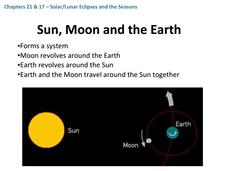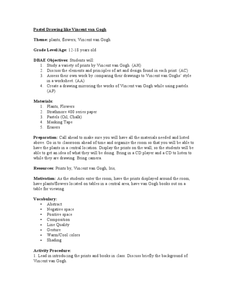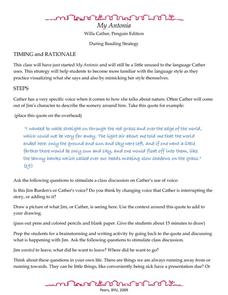Mathematics Vision Project
Module 5: Modeling with Geometry
Solids come in many shapes and sizes. Using geometry, scholars create two-dimensional cross-sections of various three-dimensional objects. They develop the lesson further by finding the volume of solids. The module then shifts to finding...
Curated OER
Shaded Bottles
Learners draw, and then paint three-dimensional bottles to practice shading which shows shape and perspective. The step-by-step process for creating dimensional still life art is outlined, which makes teaching art an attainable task. Oil...
Asian Art Museum
Japanese Architecture for Elementary School Students
Art and architecture go hand-in-hand. Kids watch clips from the Hayo Miyazaki film Spirited Away to better understand Japanese customs and architecture. The discussion questions included are very good, and will help you lead the class in...
PBS
Cloud Clues
It's cloudy with a good chance of learning! An inquiry-based lesson begins with an exploration of transparent, translucent, and opaque materials. Young scientists then connect their learning to the different cloud types as they take the...
Curated OER
Relief Drawing
High schoolers choose an interesting view for an art relief project. They outline their composition, and shade their relief using charcoal pencil. The results are fabulous! One nice thing about this art project is that the materials...
Calvin Crest Outdoor School
Survival
Equip young campers with important survival knowledge with a set of engaging lessons. Teammates work together to complete three outdoor activities, which include building a shelter, starting a campfire, and finding directions in the...
Curated OER
Solar/Lunar Eclipses and the Seasons
How do the moon, sun, and Earth line up to create eclipses? Why do the seasons change throughout a year? The answers to these questions are explained through this series of slides. This apt presentation outlines information using bullet...
Curated OER
It's too loud!
Investigate soft, loud, and dangerous sounds. Little ones put a check next to the sounds that are loud, an X next to ones that are soft, and circle the ones that would require protective ear wear. Tip: Get out a tape player or computer...
Sargent Art
Picasso and Beyond!
After reviewing the life and art of Pablo Picasso, learners set out to create abstract, cubist, relief portraits. They'll draw, color, paint, and cut out portraits just like the ones Picasso created. The lesson is extremely well written...
K12 Reader
Phases of the Moon
Take one giant leap for mankind with a reading passage about the moon. Kids learn about the lunar cycle with context clues and reading comprehension questions, making it a good informational text for your language arts lesson.
Exploratorium
Seeing Your Retina
Using a dimmed flashlight, life science learners can see the network of blood vessels that line the back of their eye. Darken the room and let them try this activity as part of your unit on the eyeball. Also consider some of the other...
North American Montessori Center
Sun and Moon Autumnal Equinox Activities
Two hands-on activities celebrate the sun and moon autumnal equinox. First, scholars create a cairn using a shoebox, flashlight, and drawing tools to view the sun's progression. Second, learners take to the kitchen to bake mooncakes and...
BBC
Sound and Hearing
First and second graders recognize that sound is generated in a variety of ways, and that it comes from many different sources. They explore tone and volume, realizing that there are different ways to describe sound. Some musical...
BBC
Ourselves
Young biologists identify parts of the body, sort humans from other animals, and list the difference they see. Learners are split up into groups of three, and each group must find pictures in magazines of humans and other animals. They...
Curated OER
Colored Pencil Value Practice
Budding artists discover what color value means with regard to art. They read the definition of color value at the top of the page, choose three different colored pencils, then use the provided spaces to create color values with each. By...
Curated OER
Celebrate With Silhouettes
Students explore history of silhouettes, and help create keepsake silhouettes, frame them, or use them to make a special Mother's Day card.
Memorial Art Gallery
Art Alive! - Beach at Blue Point
And then what happened? Class members engage in a series of activities that model for them how to read the story in a painting. Participants respond to questions that ask them to closely examine the elements in William Glackens' "Beach...
Curated OER
Pastel Drawing like Vincent Van Gogh
Learners discuss the elements of art and design found in a series of flower paintings by Vincent Van Gogh. They explore art, shading, and color as they create mirrored representations of the master's art, using oil pastel.
J. Paul Getty Trust
O Greek Shape! O Fair Pose!
Everything old is new again. The Los Angeles J. Paul Getty Museum presents a lesson on how Greek black-figure painting influenced eighteenth century Neoclassical artists. After looking at a series of examples, class members create their...
Curated OER
The Art of the Italian Renaissance
Feast your eyes on some of the most beautiful and important art of the Renaissance, including paintings, sculptures, and architecture. The slides take care to detail the characteristics of each art form, but the presentation really lends...
Asian Art Museum
Community Identity?
To better understand the contemporary arts movement in Japan, learners engage in a guided discussion. They view several photograms by the artist Kunie Sugirua, then discuss the elements of art and techniques used to create each piece....
Biology Class
Scientific Method Worksheet
Knowing the names of the steps of the scientific method is not enough; in order to really understand each of the elements, one must practice. Beginning with an engaging recap of the steps of the scientific method, learners practice the...
Curated OER
My Antonia: During Reading Strategy
Home in on the quote on this page to explore setting, the author's and character's voices, and plot in Willa Cather's My Antonia. Pupils draw a picture of what is described in the quote, discuss the content, and make connections to their...
University of Texas
Observing the Moon
Why does it look like there is a man on the moon? Why does the moon look different every night? These are the focus questions of a lesson that prompts class members to observe and record the nightly changes of Earth's natural satellite.
Other popular searches
- Drawing Light and Shadows
- Art Light and Shadows
- Shadows and Light
- Science Light and Shadows
- Physics Light and Shadows
- Light Shadows Questions
- Light and Shadows Worksheets
- Light and Shadows Angle
- Science Light and Shadows

























